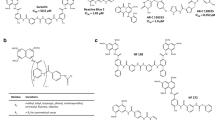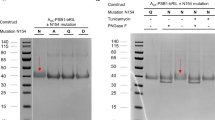Abstract
The Gq protein-coupled, ATP- and UTP-activated P2Y2 receptor is a potential drug target for a range of different disorders, including tumor metastasis, inflammation, atherosclerosis, kidney disorders, and osteoporosis, but pharmacological studies are impeded by the limited availability of suitable antagonists. One of the most potent and selective antagonists is the thiouracil derivative AR-C118925. However, this compound was until recently not commercially available and little is known about its properties. We therefore developed an improved procedure for the synthesis of AR-C118925 and two derivatives to allow up-scaling and assessed their potency in calcium mobilization assays on the human and rat P2Y2 receptors recombinantly expressed in 1321N1 astrocytoma cells. The compound was further evaluated for inhibition of P2Y2 receptor-induced β-arrestin translocation. AR-C118925 behaved as a competitive antagonist with pA 2 values of 37.2 nM (calcium assay) and 51.3 nM (β-arrestin assay). Selectivity was assessed vs. related receptors including P2X, P2Y, and adenosine receptor subtypes, as well as ectonucleotidases. AR-C118925 showed at least 50-fold selectivity against the other investigated targets, except for the P2X1 and P2X3 receptors which were blocked by AR-C118925 at concentrations of about 1 μM. AR-C118925 is soluble in buffer at pH 7.4 (124 μM) and was found to be metabolically highly stable in human and mouse liver microsomes. In Caco2 cell experiments, the compound displayed moderate permeability indicating that it may show limited peroral bioavailability. AR-C118925 appears to be a useful pharmacological tool for in vitro and in vivo studies.










Similar content being viewed by others
Abbreviations
- AIBN:
-
Azobisisobutyronitrile
- AP4A:
-
Diadenosine tetraphosphate
- AR-C118925:
-
5-{[5-(2,8-Dimethyl-5H-dibenzo[a,d]cyclohepten-5-yl)-3,4-dihydro-2-oxo-4-thioxo-1(2H)-pyrimidinyl]methyl}-N-(1H-tetrazol-5-yl)-2-furancarboxamide
- ATP:
-
Adenosine-5′-triphosphate
- CHO:
-
Chinese hamster ovary
- CYP:
-
Cytochrome P450
- DMEM:
-
Dulbecco’s modified Eagle’s medium
- DMF:
-
Dimethylformamide
- DMF-DEA:
-
Dimethylformamide-diethylacetal
- E5′-NT:
-
Ecto-5′-nucleotidase
- EDTA:
-
Ethylenediaminetetraacetic acid
- Fluo-4AM:
-
Fluo-4 acetoxymethyl ester
- MRS2768:
-
Uridine-5′-tetraphosphate δ-phenyl ester tetrasodium salt
- HBSS:
-
Hank’s balanced salt solution
- HMDS:
-
Hexamethyldisilazane
- hNPP1:
-
Human nucleotide pyrophosphatase subtype 1
- hNTPDase2:
-
Human nucleoside triphosphate diphosphohydrolase subtype 2
- HOBt:
-
Hydroxybenzotriazole
- LDA:
-
Lithium diisopropylamide
- NBS:
-
N-Bromosuccinimide
- rt:
-
Room temperature
- SEM:
-
Standard error of the mean
- THF:
-
Tetrahydrofuran
- UTP:
-
Uridine-5′-triphosphate
- vs:
-
Versus
References
Abbracchio MP, Burnstock G, Boeynaems JM, Barnard EA, Boyer JL, Kennedy C, Knight GE, Fumagalli M, Gachet C, Jacobson KA, Weisman GA (2006) International Union of Pharmacology LVIII: update on the P2Y G protein-coupled nucleotide receptors: from molecular mechanisms and pathophysiology to therapy. Pharmacol Rev 58:281–341
Lustig KD, Shiau AK, Brake AJ, Julius D (1993) Expression cloning of an ATP receptor from mouse neuroblastoma cells. Proc Natl Acad Sci U S A 90:5113–5117
Murthy KS, Makhlouf GM (1998) Coexpression of ligand-gated P2X and G protein-coupled P2Y receptors in smooth muscle. Preferential activation of P2Y receptors coupled to phospholipase C (PLC)-beta1 via Galphaq/11 and to PLC-beta3 via Gbetagammai3. J Biol Chem 273:4695–4704
Bagchi S, Liao Z, Gonzalez FA, Chorna NE, Seye CI, Weisman GA, Erb L (2005) The P2Y2 nucleotide receptor interacts with alphav integrins to activate go and induce cell migration. J Biol Chem 280:39050–39057
Liao Z, Seye CI, Weisman GA, Erb L (2007) The P2Y2 nucleotide receptor requires interaction with alpha v integrins to access and activate G12. J Cell Sci 120:1654–1662
Baltensperger K, Porzig H (1997) The P2U purinoceptor obligatorily engages the heterotrimeric G protein G16 to mobilize intracellular Ca2+ in human erythroleukemia cells. J Biol Chem 272:10151–10159
Moore DJ, Chambers JK, Wahlin JP, Tan KB, Moore GB, Jenkins O, Emson PC, Murdock PR (2001) Expression pattern of human P2Y receptor subtypes: a quantitative reverse transcription-polymerase chain reaction study. Biochim Biophys Acta 1521:107–119
Cressman VL, Lazarowski E, Homolya L, Boucher RC, Koller BH, Grubb BR (1999) Effect of loss of P2Y(2) receptor gene expression on nucleotide regulation of murine epithelial Cl(−) transport. J Biol Chem 274:26461–26468
Hochhauser E, Cohen R, Waldman M, Maksin A, Isak A, Aravot D, Jayasekara PS, Müller CE, Jacobson KA, Shainberg A (2013) P2Y receptor agonist with enhanced stability protects the heart from ischemic damage in vitro and in vivo. Purinergic Signal 9:633–642
Camden JM, Schrader AM, Camden RE, Gonzalez FA, Erb L, Seye CI, Weisman GA (2005) P2Y2 nucleotide receptors enhance alpha-secretase-dependent amyloid precursor protein processing. J Biol Chem 280:18696–18702
Xing M, Post S, Ostrom RS, Samardzija M, Insel PA (1999) Inhibition of phospholipase A2-mediated arachidonic acid release by cyclic AMP defines a negative feedback loop for P2Y receptor activation in Madin-Darby canine kidney D1 cells. J Biol Chem 274:10035–10038
Xu J, Weng YI, Simonyi A, Krugh BW, Liao Z, Weisman GA, Sun GY (2002) Role of PKC and MAPK in cytosolic PLA2 phosphorylation and arachadonic acid release in primary murine astrocytes. J Neurochem 83:259–270
Xu J, Chalimoniuk M, Shu Y, Simonyi A, Sun AY, Gonzalez FA, Weisman GA, Wood WG, Sun GY (2003) Prostaglandin E2 production in astrocytes: regulation by cytokines, extracellular ATP, and oxidative agents. Prostaglandins Leukot Essent Fatty Acids 69:437–448
Welch BD, Carlson NG, Shi H, Myatt L, Kishore BK (2003) P2Y2 receptor-stimulated release of prostaglandin E2 by rat inner medullary collecting duct preparations. Am J Physiol Renal Physiol 285:F711–F721
Seye CI, Kong Q, Erb L, Garrad RC, Krugh B, Wang M, Turner JT, Sturek M, Gonzalez FA, Weisman GA (2002) Functional P2Y2 nucleotide receptors mediate uridine 5′-triphosphate-induced intimal hyperplasia in collared rabbit carotid arteries. Circulation 106:2720–2726
Schumacher D, Strilic B, Sivaraj KK, Wettschureck N, Offermanns S (2013) Platelet-derived nucleotides promote tumor-cell transendothelial migration and metastasis via P2Y2 receptor. Cancer Cell 24:130–137
Wilden PA, Agazie YM, Kaufman R, Halenda SP (1998) ATP-stimulated smooth muscle cell proliferation requires independent ERK and PI3K signaling pathways. Am J Phys 275:H1209–H1215
Tu MT, Luo SF, Wang CC, Chien CS, Chiu CT, Lin CC, Yang CM (2000) P2Y(2) receptor-mediated proliferation of C(6) glioma cells via activation of Ras/Raf/MEK/MAPK pathway. Br J Pharmacol 129:1481–1489
Muscella A, Elia MG, Greco S, Storelli C, Marsigliante S (2003) Activation of P2Y2 receptor induces c-FOS protein through a pathway involving mitogen-activated protein kinases and phosphoinositide 3-kinases in HeLa cells. J Cell Physiol 195:234–240
Schafer R, Sedehizade F, Welte T, Reiser G (2003) ATP- and UTP-activated P2Y receptors differently regulate proliferation of human lung epithelial tumor cells. Am J Physiol Lung Cell Mol Physiol 285:L376–L385
Greig AV, Linge C, Cambrey A, Burnstock G (2003) Purinergic receptors are part of a signaling system for keratinocyte proliferation, differentiation, and apoptosis in human fetal epidermis. J Invest Dermatol 121:1145–1149
Malam-Souley R, Seye C, Gadeau AP, Loirand G, Pillois X, Campan M, Pacaud P, Desgranges C (1996) Nucleotide receptor P2u partially mediates ATP-induced cell cycle progression of aortic smooth muscle cells. J Cell Physiol 166:57–65
Miyagi Y, Kobayashi S, Ahmed A, Nishimura J, Fukui M, Kanaide H (1996) P2U purinergic activation leads to the cell cycle progression from the G1 to the S and M phases but not from the G0 to G1 phase in vascular smooth muscle cells in primary culture. Biochem Biophys Res Commun 222:652–658
Kishore BK, Carlson NG, Ecelbarger CM, Kohan DE, Müller CE, Nelson RD, Peti-Peterdi J, Zhang Y (2015) Targeting renal purinergic signalling for the treatment of lithium-induced nephrogenic diabetes insipidus. Acta Physiol 214:176–188
Hoebertz A, Mahendran S, Burnstock G, Arnett TR (2002) ATP and UTP at low concentrations strongly inhibit bone formation by osteoblasts: a novel role for the P2Y2 receptor in bone remodeling. J Cell Biochem 86:413–419
Brunschweiger A, Müller CE (2006) P2 receptors activated by uracil nucleotides—an update. Curr Med Chem 12:763–771
Kemp PA, Sugar RA, Jackson AD (2004) Nucleotide-mediated mucin secretion from differentiated human bronchial epithelial cells. Am J Respir Cell Mol Biol 31:446–455
Meghani P (2002) The design of P2Y2 antagonists for the treatment of inflammatory diseases. American Chemical Society Division of Medicinal Chemistry Abstracts of 224th ACS National Meeting
Cosentino S, Banfi C, Burbiel JC, Luo H, Tremoli E, Abbracchio MP (2012) Cardiomyocyte death induced by ischaemic/hypoxic stress is differentially affected by distinct purinergic P2 receptors. J Cell Mol Med 16:1074–1084
Önnheim K, Christenson K, Gabl M, Burbiel JC, Müller CE, Oprea TI, Bylund J, Dahlgren C, Forsman H (2014) A novel receptor cross-talk between the ATP receptor P2Y2 and formyl peptide receptors reactivates desensitized neutrophils to produce superoxide. Exp Cell Res 323:209–217
Wang S, Iring A, Strilic B, Albarrán Juárez J, Kaur H, Troidl K, Tonack S, Burbiel JC, Müller CE, Fleming I, Lundberg JO, Wettschureck N, Offermanns S (2015) P2Y2 and Gq/G11 control blood pressure by mediating endothelial mechanotransduction. J Clin Invest 125:3077–3086
Hilbert G, Jansen E (1934) Action of alkali and ammonia on 2,4-dialkoxypyrimidines. JACS 56:134–139
Whittaker N (1953) Notes J Chem Soc:1646
Wheeler HL, Bristol HS (1905) Amer Chem J 32:437
Kindon N, Meghani P, Thom S (1998) Novel Compounds. WO1998054180
Knight D, Nott A (1981) The generation and chemistry of dianions derived from furancarboxylic acids. J Chem Soc 1125–1131
Hillmann P, Ko GY, Spinrath A, Raulf A, von Kügelgen I, Wolff SC, Nicholas RA, Kostenis E, Holtje HD, Müller CE (2009) Key determinants of nucleotide-activated G protein-coupled P2Y(2) receptor function revealed by chemical and pharmacological experiments, mutagenesis and homology modeling. J Med Chem 52:2762–2775
Hernandez-Olmos V, Abdelrahman A, El-Tayeb A, Freudendahl D, Weinhausen S, Müller CE (2012) N-substituted phenoxazine and acridone derivatives: structure–activity relationships of potent P2X4 receptor antagonists. J Med Chem 55:9576–9588
Fuchs A, Rempel V, Müller CE (2013) The natural product magnolol as a lead structure for the development of potent cannabinoid receptor agonists. PLoS One 8:e77739
Burbiel J (2006) On the syntheses of dibenzosuberenone and 2,8-dimethyldibenzosuberenone. ARKIVOC xiii:16–21
Wild H, Hansen J, Lautz J, Paessens A (1993) 5-Oxo-dibenzo[a,d]cyclohepta-1,4-dienes and their use as retroviral agents. Eur Pat 0589322:A1
Vaclavikova R, Horsky S, Simek P, Gut I (2003) Paclitaxel metabolism in rat and human liver microsomes is inhibited by phenolic antioxidants. Naunyn Schmiedeberg's Arch Pharmacol 368:200–209
Hidalgo IJ, Raub TJ, Borchardt RT (1989) Characterization of the human colon carcinoma cell line (Caco-2) as a model system for intestinal epithelial permeability. Gastroenterology 96:736–749
Acknowledgments
This study was supported by the Ministry for Innovation, Science, Research and Technology of the State of North Rhine-Westphalia through the NRW International Graduate Research School Biotech-Pharma (M.R., C.E.M.). We thank Amelie Fiene, Angelika Fischer, Marianne Freundlieb, Sonja Hinz, Sangyong Lee, Anika Püsche, Anja B. Scheiff, Clara B. Schoeder, and Stefanie Weyer for selectivity testing.
Author information
Authors and Affiliations
Corresponding author
Ethics declarations
Conflict of interest
The authors declare that there is no conflict of interest.
Electronic supplementary material
ESM. 1
Supporting information includes the descriptions of in vitro assays used for selectivity testing, data on targets not directly related to the P2Y2 receptor, potency and efficacy results for the concentration-effect curves of UTP following pre-incubation with different, fixed concentrations of AR-C118925, and additional data on the physicochemical and pharmacokinetic properties of AR-C118925. (PDF 303 kb)
Rights and permissions
About this article
Cite this article
Rafehi, M., Burbiel, J.C., Attah, I.Y. et al. Synthesis, characterization, and in vitro evaluation of the selective P2Y2 receptor antagonist AR-C118925. Purinergic Signalling 13, 89–103 (2017). https://doi.org/10.1007/s11302-016-9542-3
Received:
Accepted:
Published:
Issue Date:
DOI: https://doi.org/10.1007/s11302-016-9542-3




